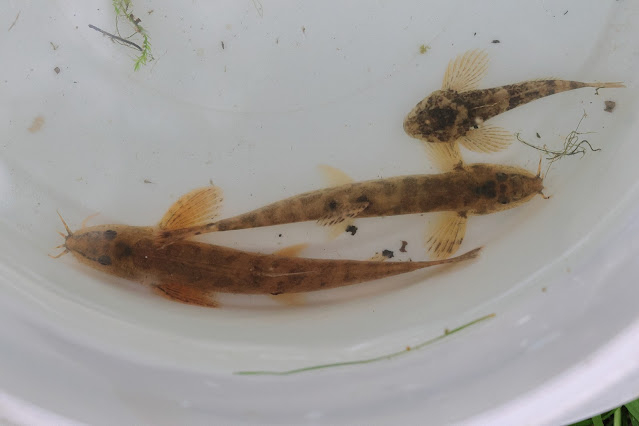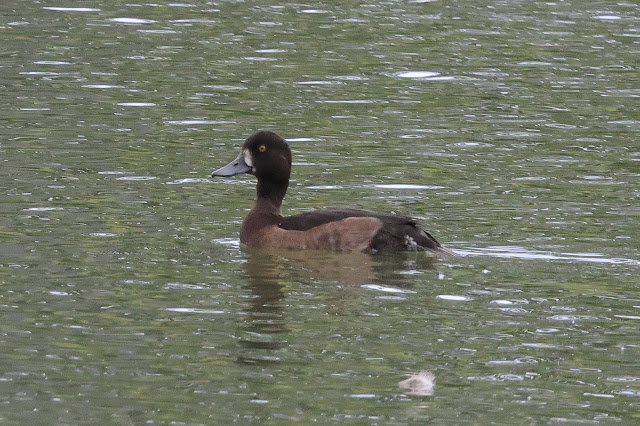21st August 2024 - John W spotted this female Southern Hawker dragonfly, apparently laying eggs in one of his small 'bucket ponds'.
Sightings and news for the Naturewatch group of Great and Little Abington in Cambridgeshire, UK. See below for more details and information on how to join.
Saturday, 24 August 2024
Rivercare - August sampling results
19th August 2024 - the RiverCare team undertook their monthly river sampling of the Granta at the ford in Abington, and the results are shown below. Generally, the sample was a bit more spare than in previous months, but most of the usual species were present, but in lower numbers. More unusual were the two Stone Loach and two Bullhead fish caught in the sampling.
Common Darter and Emerald Damselfly
18th August 2024 - a female Common Darter was seen in Lagden's Grove on Granta Park, well away from water and perching on flower stems and leaves, occasionally darting out to catch a passing insect. Near the lake, a more uncommon species, an Emerald Damselfly - this group of damselflies being unusual in that they hold their wings diagonally to the body when resting, rather than alongside the body as is more usual for damselflies. Andy M.
Butterflies and Moths on a Granta Park walk
18th August 2024 - walking through the wildflower meadows on Granta Park, Andy M spotted a few Common Blue butterflies - the males showing their bright blue upperside wings whilst in flight, with the female upper sides being mostly brown with a blush of blue near the body. A Large White was seen nearer the river, being mostly white, but with the black tip extending down the side of the upper wing, and two Meadow Brown were seen flying around, locked together as a mating pair.
A small, and very daintily patterned Latticed Heath moth was seen on Lady's Bedstraw flowers, and a strikingly patterned Treble-bar moth seen resting in the long grass.
Tufted Duck, and other birds, on Granta Park
18th August 2024 - Andy M took his camera for a walk around Granta Park, and was very happy to see a female Tufted Duck on the lake, alongside a considerable number of Canada Goose, several Barnacle Goose and a Greylag. The large number of Mallard were still in moult, so all appeared as if in female plumage, although the males could still be distinguished by their yellow-green bill, whereas the female bill is more brown and orange. A good sized flock of House Martin flitted overhead, occasionally 'splashing- down' to take a drink or a brief bathe, whilst in the reed bed the Reed Warbler were still skulking around, making their grating, short contact calls. On the cricket green a dispersed flock of Pied Wagtail, including many juveniles at this time of year, scurried around feeding, on flies, grubs etc.
NatureWatch trip to Wicken Fen
18th August 2024 - our last planned NatureWatch trip of the year was to Wicken Fen to see dragonflies, butterflies and anything else of interest. Seven members and a grandchild joined the boardwalk route around the only remaining unimproved fen, in lovely sunny if slightly breezy weather.
The dragonflies did not take long to find, with several darters seen hunting along the ditches, where they were more sheltered from the breeze. The small ponds provided lovely views of a Migrant Hawker dragonfly and a Moorhen, and a winding walk through the meadow revealed Ruddy Darter looking out from its blackberry perch, and a resting female Migrant Hawker. The latter species has characteristic brown and yellow patches on the thorax ('body') and a yellow T-shape on the second segment of the abdomen ('tail'). Further along, on the open water of the lode, Brown Hawker was seen patrolling over the water (the only dragonfly with brown wings), and Blue-tailed Damselfly, Common Blue Damselfly and Azure Damselfly resting on the vegetation there.
Along the more shady part of the walk, Common Darter looked out from their perches, with Peacock, Red Admiral, Essex Skipper and Speckled Wood butterflies all being seen there, whilst a group of Swallow flitted overhead, and the yellow flowers of Greater Bladderwort provided a splash of vibrant colour in the ditches there.
A few of the group then continued to Adventurer's Fen, where a Southern Hawker dragonfly was spotted resting, this species having pairs of blue dots down the abdomen (in common with other species), but with the dots on the last two segments characteristically linked to become blue bands. A Little Owl could also be seen on the wood pile where it, and maybe its relatives, have lived for many years.
The Aims of Abington Naturewatch
At their meeting on 9 April 2005 the members approved this revised version of the aims of Abington Naturewatch:
- To monitor and record the wildlife (fauna & flora) within the borders of the Abingtons;
- To encourage protection of our wildlife, maintain its quality and foster its diversity;
- To promote awareness of the richness, potential and problems of the natural environment of the Abingtons;
- To cooperate in improving access to the local natural environment for the benefit of all Abington villagers.
The organisation is informal and communication is by email if possible; members are notified of events from time to time. Contact details are maintained by a small "project team". There is currently no membership fee as costs are covered by voluntary contributions at events.
Members are encouraged to report notable sightings of flora and fauna within the Abingtons to the appropriate sector coordinator and an illustrated record is published annually.
A map of the area covered, with some features noted, is available here: http://maps.google.co.uk/maps/ms?ie=UTF8&hl=en&msa=0&msid=213774935674882866424.00000111dca2be9f06ab8&z=13>
For more information or to join, please contact David Farrant on (01223) 892871.
Contributions to our records should be sent to sector contacts or either of the above. Photographs may also be submitted to Andy Merryweather (amerryweather61@gmail.com)





















































